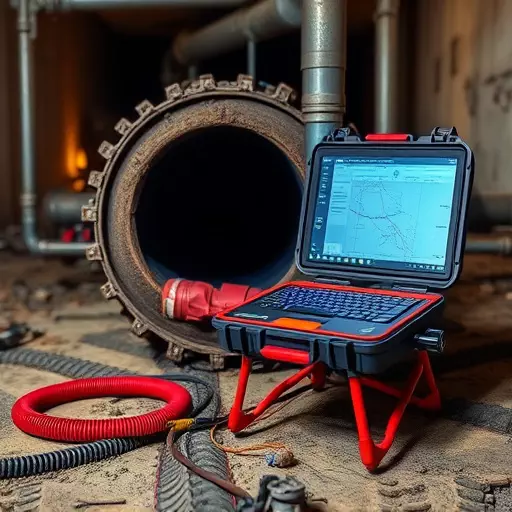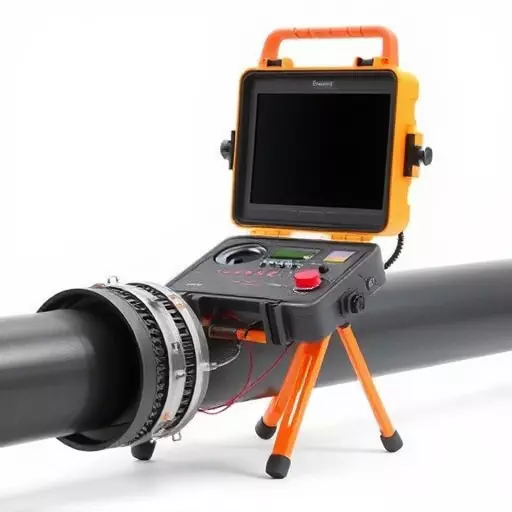Sonde and locating techniques using electromagnetic signals are vital for safe and efficient identification of underground pipes and utilities in urban areas like Toledo. Sonde equipment emits RF pulses to track metal, plastic, or concrete pipelines with remarkable accuracy, enhancing construction, maintenance, and repair processes while minimizing damage. Combining active signaling with passive locating improves efficiency. These methods are indispensable in pipe locating and utility management, applied across diverse industries including environmental remediation and archaeological exploration. Best practices, including proper training, equipment calibration, and meticulous documentation, ensure accurate results when using sonde and locating Toledo techniques.
Electromagnetic locating with a sonde is a powerful technology for precise pipe detection, offering an efficient solution for professionals in various industries. This article delves into the fundamentals of electromagnetic locating, highlighting the critical role of sonde equipment in streamlining pipe locating processes. We explore diverse sonde and locating techniques, analyze its advantages and limitations, and discuss ideal application areas. Best practices and tips are provided to ensure effective sonde utilization for accurate pipe mapping. Discover how this technology, combining sonde equipment with electromagnetic principles, revolutionizes pipe locating in Toledo and beyond.
- Understanding Electromagnetic Locating: A Foundation for Pipe Detection
- The Role of Sonde Equipment in Efficient Pipe Locating
- Different Techniques of Using a Sonde for Accurate Locating
- Advantages and Limitations of Electromagnetic Locating with Sonde
- Application Areas: Where Sonde and Locating Technologies Excel
- Best Practices and Tips for Effective Sonde Use in Pipe Locating
Understanding Electromagnetic Locating: A Foundation for Pipe Detection

Electromagnetic locating is a precise and efficient method used to detect underground pipes, cables, and other utilities. At its core, this technique leverages electromagnetic fields to pinpoint the exact location of metallic objects buried beneath the earth’s surface. A sonde, specialized equipment at the heart of this process, emits an electromagnetic signal that interacts with nearby metal structures, enabling their detection. The data collected from these interactions is then processed to create a detailed map, revealing the underground layout.
This technology has become indispensable in various industries, particularly in construction and utility management. Sonde and locating techniques have revolutionized how professionals navigate beneath our cities. By employing these tools, workers can safely and accurately locate pipes, avoiding costly damage during excavation projects. This foundation of understanding electromagnetic locating with sondes empowers efficient, safe, and informed decision-making when dealing with critical infrastructure.
The Role of Sonde Equipment in Efficient Pipe Locating

The role of sonde equipment is pivotal in the efficient pipe locating process, enhancing precision and speed. Sonde, a specialized device, is designed to emit electromagnetic signals that can penetrate soil and locate underground pipes with remarkable accuracy. By using advanced sonde equipment for pipe locating, professionals can navigate through complex underground networks without the need for invasive excavation methods. This non-destructive approach not only saves time but also minimizes damage to surrounding structures or utilities.
In the realm of locating Toledo (or any urban area), sonde and locating techniques have become indispensable tools. The ability to quickly and accurately identify pipe locations ensures efficient maintenance, repairs, and new installations. With precise data from sonde equipment, professionals can avoid costly mistakes, reduce service disruptions, and ensure the integrity of critical underground infrastructure.
Different Techniques of Using a Sonde for Accurate Locating

In the realm of electromagnetic locating, the sonde plays a pivotal role in achieving precise results. Sonde equipment for pipe locating is designed to emit electromagnetic signals that can be detected and tracked, enabling professionals to pinpoint underground utilities with remarkable accuracy. One of the primary techniques involves using the sonde to send out radio frequency (RF) pulses, which are then received by a receiver antenna. This method, known as active signaling, allows for real-time tracking, making it ideal for navigating complex urban landscapes like Toledo.
Beyond active signaling, passive locating is another powerful technique. Here, the sonde does not emit signals but instead detects electromagnetic fields generated by existing power lines and other utilities. This approach leverages the natural signals in the environment, enhancing efficiency and reducing interference. By combining these various locating techniques, professionals can adapt to different scenarios, ensuring optimal results for even the most challenging pipe-locating tasks.
Advantages and Limitations of Electromagnetic Locating with Sonde

Electromagnetic locating with sonde offers several advantages in the field of pipe and utility mapping. This non-invasive technique employs electromagnetic signals to accurately identify and locate underground pipes, cables, and other utilities. One significant benefit is its versatility; sonde equipment for pipe locating can detect a wide range of materials, including metal, plastic, and concrete, making it suitable for various industries like construction, telecommunications, and water management. The technology also ensures precise results, minimizing the risk of damage to underground infrastructure during excavation projects.
However, despite these advantages, electromagnetic locating with sonde is not without limitations. Factors such as signal interference from nearby metals or electrical equipment can affect accuracy. Additionally, the technique may struggle with deep or buried objects that weaken the electromagnetic field. Locating techniques using sondes also rely on careful calibration and skilled operators to interpret data effectively. Moreover, in areas with complex geological formations, the signals might bounce or refract unpredictably, making precise locating challenging.
Application Areas: Where Sonde and Locating Technologies Excel

The application areas of sonde and locating technologies are vast and varied, showcasing their versatility in several industries. Sonde and locating techniques excel in pipe locating, enabling efficient identification and mapping of underground pipelines. This is particularly crucial for construction projects aiming to avoid damage to vital infrastructure. Moreover, these technologies find extensive use in utility management, helping utilities companies locate and maintain their networks accurately and swiftly.
Beyond pipeline and utility sectors, sonde equipment for pipe locating also proves invaluable in environmental remediation, archaeological exploration, and even oil and gas drilling. Their ability to navigate complex underground landscapes makes them indispensable tools for navigating the challenges posed by diverse terrain and subterranean conditions, ensuring safety, efficiency, and precision in various operations.
Best Practices and Tips for Effective Sonde Use in Pipe Locating

When utilizing sonde equipment for pipe locating, adherence to best practices ensures accurate and efficient results. Start by thoroughly preparing the area; clear debris and ensure no active electrical currents are present in the vicinity to avoid interference or safety hazards. Proper training is paramount; understand your sonde’s capabilities and limitations, as well as the specific locating techniques required for different pipe materials and environments.
During operation, maintain consistent pressure on the sonde while slowly advancing it through the ground. Regularly interpret the sonar readings to pinpoint the pipe’s location accurately. Document findings meticulously, noting depths, distances, and any anomalies. Regular calibration of your sonde equipment is also crucial for ensuring precise locating results in Toledo and beyond.


